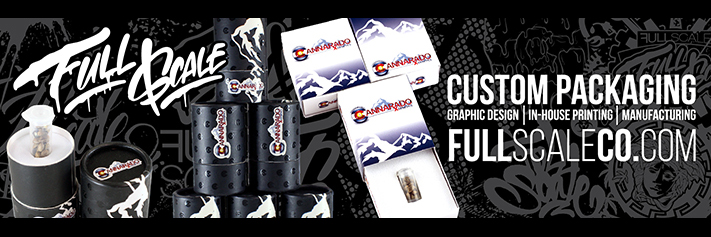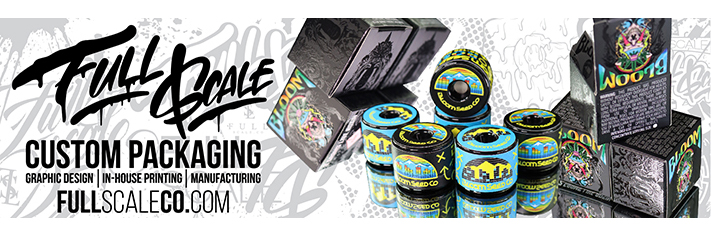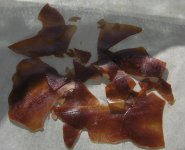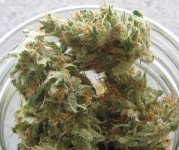Graywolf
Well-known member
Quick Wash Isopropyl, also know as QWISO is one of the techniques employed to extract oil from cannabis.
It is a popular form of extraction where high purity Ethanol is either not available or priced out of reach. It even has a following that swears it is the only way to fly.
I will show it here in its simplest form, as well as the way we normally process QWISO at the skunk pharm to produce an absolute from the oleoresin extracted, for use in topicals.
As most of our extracted QWISO goes into topical meds, we also decarboxylate ours. This process is based on the 252F curve shown in the attached graph; I copied from Jump 117 in Moscow.
The first question is why use a quick wash technique to extract the resins, instead of long soaks to extract as much resin as possible, or just boiling the material in alcohol to get the greatest amount of extracted material?
The answer to that is that because alcohol is a highly polar solvent that is soluble in water, the latter two techniques also extract the water solubles like chlorophyll and plant alkaloids, as well as the plant waxes and vegetable oil.
Even quick wash does to a lesser degree, but the added steps that we include here minimize pickup even further and we take additional steps to remove the impurities that we do pick up.
The first wash will usually extract 75 to 80%, leaving the balance for the second. The second extraction will be more sedative and less heady. If you use a hand microscope, you can easily see when the trichome heads are gone and the stalks look like wet fur.
A cured material QWISO absolute is one of the most aromatic and tasty of the extraction methods and consistently gets high raves from the volunteer test panels, as well as the patients and students. Both from an efficacy, as well as a flavor standpoint.
The first step in the process is to get as much water as possible out of the material.
This procedure is specifically for material that has been cured to about 15% water content, which is typical of cured material. 15% is a lot of water and the alcohol already has 5% in it, so unless we reduce the water content even further, we will be extracting a lot of water solubles.
We dry our cured material even further by spreading it on a cookie sheet and baking it in a 200F oven until just frangible when rolled between the finger and thumb.
At this point, for the most pristine extract, we simply coarsely break down buds by hand and load the material into jars. Leaves and trim are just lightly compacted as is.
Or we can scrub it through a wire mesh pasta strainer, using a leather gloved hand and firm pressure, so as to maximize space, but still generate fewer fine particles than grinding in a food processor or blender.
We never, ever, use a blender or coffee grinder to reduce material, because it produces a lot of ultra fine powder that makes it through conventional filters.
The stems will be left behind if you strain, which I encourage you to save for a different extraction, and make a killer topical out of them. If you leave them in the extraction, they will leave some of their flavor behind.
Next, while it is still warm, we seal the material in a jar, which we place in the freezer to tie up any remaining water as ice. We also put the 99% Isoproypl alcohol in the freezer.
When they have both stabilized at about 0F, pour the alcohol into the jar of plant material, so that it is at least an inch above the material, and shake it gently for 15/20 seconds.
At the end of 15/20 seconds, dump it through a wire strainer to drain quickly.
Set the material aside to dry for a second extraction. We usually keep the two extractions separate, as they will have different properties.
Filter the extracted liquid.
We use either a vacuum filter or a simple coffee filter, depending on the quantity we are processing.
A couple different ways to go at this point. One is to pour the alcohol wash in shallow Pyrex pie plates and use natural evaporation or fans to evaporate away the alcohol.
Another is to place that filtered liquid in a suitable container and set that container in an oil bath heated to 240/250F. We use bain marie and other stainless ware from a restaurant supply.
Make sure that the container is sitting on something that suspends it up off the bottom of the oil pot. I throw four jar lids in the bottom of my electric fondue pot and use it for that purpose.
Never trust the numbers on the dial and use a good thermometer to set temperatures. We use either a mercury lab thermometer, or a digital one. Good temperature control is key to the process.
That means the device that you use to control the oil temperature must have a narrow dead band, so that the temperature control is stable.
I paid about $60 for a Quisinart fondue pot that was designed to heat sensitive sauces like chocolate and has excellent control throughout its temperature range. There are a couple of Revels in our group that are slightly larger and work well, plus cost only about $30, though they have a slightly larger dead band.
Some fry cookers have sensitive enough controls, but many deep fryers designed to primarily run at 375F, lack control sensitivity and have large dead bands at 250F.
Boil off the alcohol until the liquid is reduced to a pool of oil and all but minor bubbles cease rising at the edges and then pour at least ten volumes of alcohol and wash out the whole pot by swirling it and washing off any resin stuck to the sides.
Using a funnel, pour that liquid into a jar or bottle, seal it, and place that in the freezer.
I usually leave it at least overnight, but have pushed it to a couple hours. The liquid will lose its clarity and become slightly cloudy, primarily from plant waxes flocculating out. There will also be precipitant on the bottom of the container.
Carefully decant and filter that liquid one more time, and you will have a bell clear extract, that is ready to reduce down one more time.
Place in a suitable container for return to the oil bath. Since you have much less material, a smaller one may be used.
At this point I put them in small stainless cups or a 250 ML beaker to reduce the surface area that will be coated with oil when I cook it down the last time.
When the oil is (mostly) bubble I free, I extract it from the container using a pipette, so as to not leave a streak of material in the vessel. After I have extracted all that I can using a pipette, I wash the container and pipette out with hot alcohol, and save the wash for the next run.
Nothing is wasted or left behind.
It is a popular form of extraction where high purity Ethanol is either not available or priced out of reach. It even has a following that swears it is the only way to fly.
I will show it here in its simplest form, as well as the way we normally process QWISO at the skunk pharm to produce an absolute from the oleoresin extracted, for use in topicals.
As most of our extracted QWISO goes into topical meds, we also decarboxylate ours. This process is based on the 252F curve shown in the attached graph; I copied from Jump 117 in Moscow.
The first question is why use a quick wash technique to extract the resins, instead of long soaks to extract as much resin as possible, or just boiling the material in alcohol to get the greatest amount of extracted material?
The answer to that is that because alcohol is a highly polar solvent that is soluble in water, the latter two techniques also extract the water solubles like chlorophyll and plant alkaloids, as well as the plant waxes and vegetable oil.
Even quick wash does to a lesser degree, but the added steps that we include here minimize pickup even further and we take additional steps to remove the impurities that we do pick up.
The first wash will usually extract 75 to 80%, leaving the balance for the second. The second extraction will be more sedative and less heady. If you use a hand microscope, you can easily see when the trichome heads are gone and the stalks look like wet fur.
A cured material QWISO absolute is one of the most aromatic and tasty of the extraction methods and consistently gets high raves from the volunteer test panels, as well as the patients and students. Both from an efficacy, as well as a flavor standpoint.
The first step in the process is to get as much water as possible out of the material.
This procedure is specifically for material that has been cured to about 15% water content, which is typical of cured material. 15% is a lot of water and the alcohol already has 5% in it, so unless we reduce the water content even further, we will be extracting a lot of water solubles.
We dry our cured material even further by spreading it on a cookie sheet and baking it in a 200F oven until just frangible when rolled between the finger and thumb.
At this point, for the most pristine extract, we simply coarsely break down buds by hand and load the material into jars. Leaves and trim are just lightly compacted as is.
Or we can scrub it through a wire mesh pasta strainer, using a leather gloved hand and firm pressure, so as to maximize space, but still generate fewer fine particles than grinding in a food processor or blender.
We never, ever, use a blender or coffee grinder to reduce material, because it produces a lot of ultra fine powder that makes it through conventional filters.
The stems will be left behind if you strain, which I encourage you to save for a different extraction, and make a killer topical out of them. If you leave them in the extraction, they will leave some of their flavor behind.
Next, while it is still warm, we seal the material in a jar, which we place in the freezer to tie up any remaining water as ice. We also put the 99% Isoproypl alcohol in the freezer.
When they have both stabilized at about 0F, pour the alcohol into the jar of plant material, so that it is at least an inch above the material, and shake it gently for 15/20 seconds.
At the end of 15/20 seconds, dump it through a wire strainer to drain quickly.
Set the material aside to dry for a second extraction. We usually keep the two extractions separate, as they will have different properties.
Filter the extracted liquid.
We use either a vacuum filter or a simple coffee filter, depending on the quantity we are processing.
A couple different ways to go at this point. One is to pour the alcohol wash in shallow Pyrex pie plates and use natural evaporation or fans to evaporate away the alcohol.
Another is to place that filtered liquid in a suitable container and set that container in an oil bath heated to 240/250F. We use bain marie and other stainless ware from a restaurant supply.
Make sure that the container is sitting on something that suspends it up off the bottom of the oil pot. I throw four jar lids in the bottom of my electric fondue pot and use it for that purpose.
Never trust the numbers on the dial and use a good thermometer to set temperatures. We use either a mercury lab thermometer, or a digital one. Good temperature control is key to the process.
That means the device that you use to control the oil temperature must have a narrow dead band, so that the temperature control is stable.
I paid about $60 for a Quisinart fondue pot that was designed to heat sensitive sauces like chocolate and has excellent control throughout its temperature range. There are a couple of Revels in our group that are slightly larger and work well, plus cost only about $30, though they have a slightly larger dead band.
Some fry cookers have sensitive enough controls, but many deep fryers designed to primarily run at 375F, lack control sensitivity and have large dead bands at 250F.
Boil off the alcohol until the liquid is reduced to a pool of oil and all but minor bubbles cease rising at the edges and then pour at least ten volumes of alcohol and wash out the whole pot by swirling it and washing off any resin stuck to the sides.
Using a funnel, pour that liquid into a jar or bottle, seal it, and place that in the freezer.
I usually leave it at least overnight, but have pushed it to a couple hours. The liquid will lose its clarity and become slightly cloudy, primarily from plant waxes flocculating out. There will also be precipitant on the bottom of the container.
Carefully decant and filter that liquid one more time, and you will have a bell clear extract, that is ready to reduce down one more time.
Place in a suitable container for return to the oil bath. Since you have much less material, a smaller one may be used.
At this point I put them in small stainless cups or a 250 ML beaker to reduce the surface area that will be coated with oil when I cook it down the last time.
When the oil is (mostly) bubble I free, I extract it from the container using a pipette, so as to not leave a streak of material in the vessel. After I have extracted all that I can using a pipette, I wash the container and pipette out with hot alcohol, and save the wash for the next run.
Nothing is wasted or left behind.



















